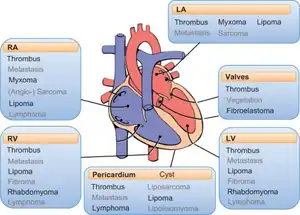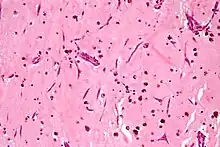Primary tumors of the heart
| Primary tumors of the heart | |
|---|---|
| Other names: Primary cardiac tumors | |
 | |
| Cardiac masses | |
| Specialty | Oncology, cardiac surgery |
| Risk factors | Genetics[1] |
| Frequency | Uncommon[2] |
Primary tumors of the heart are heart tumors that arise from the tissues that make up the heart.[2] This is in contrast to secondary tumors which spread from another part of the body.[1]
Risk factors include genetics, including some genetic syndromes.[1] The most common primary heart tumor is the papillary fibroelastoma.[2] Other types include lipomas, rhabdomyomas, fibromas, and sarcomas.[1] About 90% of primary tumors of the heart are benign, with the remaining 10% being cancerous.[1]
Primary tumors of the heart are uncommon.[3] They have been found in less than 0.3% of people at the time of death.[1] They are increasingly being encountered earlier in life with better medical imaging.[2]
Types

Benign
The most common primary tumor of the heart is the myxoma. In surgical series, the myxoma makes up as much as 77% of all primary tumors of the heart.[4] Less common tumors of the heart include lipoma and cystic tumor of the atrioventricular nodal region.
Cancerous
About 20 percent of primary tumors of the heart are cancerous in nature.[4] Malignant tumors of the heart include rhabdomyosarcomas, angiosarcomas, myxosarcomas, fibrosarcomas, leiomyosarcomas, reticulum cell sarcomas, desmoplastic small round cell tumor, and liposarcomas. The cardiac sarcomas may occur at any age, but are more commonly seen in individuals in their 20s to 40s. They occur equally in males and females.
Valvular
A subset of the primary tumors of the heart are tumors that are found on the valves of the heart. Tumors that affect the valves of the heart are found in an equal distribution among the four heart valves.[4] The vast majority of these are papillary fibroelastomas. Primary tumors of the valves of the heart are more likely to occur in males. While most primary tumors of the valves of the heart are not malignant, they are more likely to have symptoms related to the valve, including neurologic symptoms and (in a few cases) sudden cardiac death.
Prognosis
The vast majority of the tumors of the heart have a benign course and are not directly fatal. However, even the benign tumors of the heart can be lethal due to either direct extension into the electrical conduction system of the heart (causing complete heart block or a fatal dysrhythmia), or due to emboli from the tumor mass that may have lethal sequelae.
The malignant tumors of the heart have a worse prognosis. Cardiac sarcomas generally lead to death within 2 years of diagnosis, due to rapid infiltration of the myocardium of the heart and obstruction of the normal flow of blood within the heart.[5][6]
See also
References
- 1 2 3 4 5 6 Rodriguez Ziccardi, M; Tariq, MA; Limaiem, F (January 2020). "Cardiac Cancer". PMID 30725829.
{{cite journal}}: Cite journal requires|journal=(help) - 1 2 3 4 WHO Classification of Tumours Editorial Board (2021). "3. Tumours of the heart: introduction". Thoracic Tumours. Vol. 5 (5th ed.). Lyon (France): World Health Organization. pp. 228–229. ISBN 978-92-832-4506-3. Archived from the original on 2022-05-14. Retrieved 2022-07-22.
- ↑ McKenna, William J.; Elliott, Perry M. (2020). "54. Diseases of the myocardium and endocardium". In Goldman, Lee; Schafer, Andrew I. (eds.). Goldman-Cecil Medicine. Vol. 1 (26th ed.). Philadelphia: Elsevier. p. 312. ISBN 978-0-323-55087-1. Archived from the original on 2022-11-12. Retrieved 2022-11-05.
- 1 2 3 Molina JE, Edwards JE, Ward HB (1990). "Primary cardiac tumors: experience at the University of Minnesota". Thorac Cardiovasc Surg. 38 Suppl 2: 183–91. doi:10.1055/s-2007-1014064. PMID 2237900. Archived from the original on 2018-09-18. Retrieved 2022-03-14.
- ↑ Burke AP, Cowan D, Virmani R (1992). "Primary sarcomas of the heart". Cancer. 69 (2): 387–95. doi:10.1002/1097-0142(19920115)69:2<387::AID-CNCR2820690219>3.0.CO;2-N. PMID 1728367.
- ↑ Burke AP, Virmani R (1991). "Osteosarcomas of the heart". Am J Surg Pathol. 15 (3): 289–95. doi:10.1097/00000478-199103000-00009. PMID 1705103. Archived (PDF) from the original on 2021-08-29. Retrieved 2019-06-30.